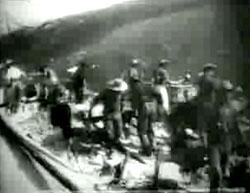 Rocking Gold in the Klondike (1901) shows men hoping to strike it rich during the Klondike gold rush. The gold "roackers" are simple devices that shake out soil & pebbles leaving behind only the heaviest metal, gold.
Rocking Gold in the Klondike (1901) shows men hoping to strike it rich during the Klondike gold rush. The gold "roackers" are simple devices that shake out soil & pebbles leaving behind only the heaviest metal, gold.
The gold rocker captures the water used to sleuce out the lighter material. You can see the men using cups to lift the reycled water back over the material.
The rocker was used mostly where there was no river or easy water source to sleuce continuously over the material being filtered.We see several men doing the rocking, a couple men bringing wheelbarrow loads of mined material to be rocked, & a rifleman standing guard. One sourdough walks through with an odd shaped bucket.
The Klondike gold in the Yukon, Canada, was the last great gold rush in North America. Robert K. Bodine's records of the working life of sourdoughs provides an amazing window on era.
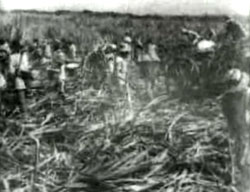 Robert Kates Bonine did other "labor actuality" films while in Hawaii, such as the half-minute Cutting Cane Sugar (1902). Robert Kates Bonine did other "labor actuality" films while in Hawaii, such as the half-minute Cutting Cane Sugar (1902).
This wee film is in very poor condition. It takes some strained looking to discover that it shows Hawaiian workers with baskets gathering cane stalks that have already been cut down. The cane is being piled onto a horse-drawn wagon.
Loading Sugar Cane (1902) is also in poor condition. It shows one or perhaps two flatbed train cars in the background (looking like a fence) with four runways propped from the cane field to the flatbeds.
Workers with cane loaded high in their arms take a running fly at the runways & when they reach the top, fling their load onto the flatbeds.
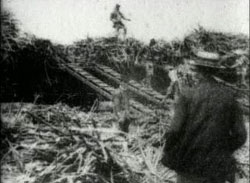 A crew boss stands nearby in his straw hat, hands in pockets, making sure the workers don't slow down. A crew boss stands nearby in his straw hat, hands in pockets, making sure the workers don't slow down.
Suddenly the field boss picks up a load & runs up a ramp himself, which he likely wouldn't've done if a camera hadn't been running. Had it been typical of him to pitch in, he wouldn't be wearing either the straw hat or the jacket.
By 1902 and 1903 when Bodine travelled about the United States & its territories making just such "actualities," the actuality genre was already in decline, in favor of films that enacted jests or stories. But some travelling picture-show men still demanded product that would permit them to narrate in any way they pleased about the palces & subjects, for travelogue programs.
So too a type of entertainment provided by the "stereopticon lecturer" likewise, to stay abreast of the times, had begun to require short moving pictures for their lectures.
Bonine would continue to provide films for these outlets until about 1907, when actualities gave way at last to much more topically current news reels. At some point he went entirely "independent" but, alas, was squeezed out of the film industry by "Associations" of film providers & film renters, veritable trusts that made it all but impossible to be a profitable independent, for exhibitors of anything not liscensed by the Trust was open to civil suits.
For other examples of Bonine's films, see Boys Diving in Honolulu (1902), two Foxy Grampa films (1902), the sexily rough & tumble A Tough Dance (1902), & Grampa's Reading Glasses (1900).
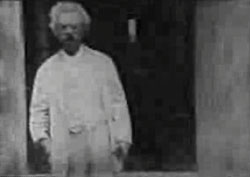 Filmed at the "Stormfield" estate, where Samuel Clemens lived for only six months, Mark Twain at Stormfield (1909) is the only moving picture footage of the author.
Filmed at the "Stormfield" estate, where Samuel Clemens lived for only six months, Mark Twain at Stormfield (1909) is the only moving picture footage of the author.
It is actually two shorter films spliced togehter. The first is Mark Twain (Samuel Clemens) Photographed by Thomas Edision (1909).
Though by its title one would suppose it was literally filmed by Thomas Edison, who was a friend of Twain's, Edison in reality never made any movies. He only lent his company name to projects.
The silent footage is very deteriorated. We first see him in his famous white suit standing in a doorway. He walks toward the camera then with a jump-cut he's walking along the front of his mansion, smoking his cigar.
He walks off-camera & the camera remains motionless, filming the front of the mansion, when almost immediately, Mark Twain comes strolling around the corner in the distance, as though he'd instantly circled the entire mansion.
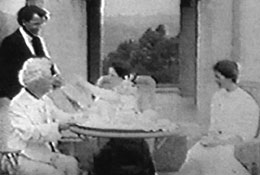 So! We're not in a little "actuality" documentary of the author at home; rather, this is a Trick Film, a jest in keeping with the nature of the author. So! We're not in a little "actuality" documentary of the author at home; rather, this is a Trick Film, a jest in keeping with the nature of the author.
The second distinct part is Mark Twain with Daughters, Clare & Jean, at 'Stormfield', Redding, Connecticut (1909). He & his grown daughters are shown in a sitting room, at a small table, playing cards & drinking tea.
A butler brings one of the daughters a bowl-shaped hat which she puts on, thrusting hat-pins into it. They all then stand up & leave the room.
Clara would be married during the short residency at Stormfield, but bad memories would soon overshadow anything good when, not long after this film was taken, Samuel's other daughter Jean drowned in her bath. In 1923, Stormfield burnt to the ground, having stood empty for many years.
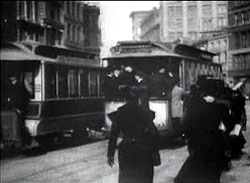 Harry Norton Marvin had been a college teacher & engineer, & a friend of pioneer filmmaker W. K-L. Dickson since before there were films to be made.
Harry Norton Marvin had been a college teacher & engineer, & a friend of pioneer filmmaker W. K-L. Dickson since before there were films to be made.
At the Mutoscope & Biograph Company, he was instrumental in the development of the mutoscope & other early film equipment. As general manager of the film studio, he was in a position to greatly influence the development of this new business of motion picture making.
He very nearly bought out Thomas Edison's film company which was slow to be profitable & was nearly jettisoned by Edison's impatience & willingness tosell to the first willing buyer. But as history would have it, Edison kept that branch of his company after all, though rarely setting foot anywhere near Black Maria Studio.
Harry's brother Arthur made films at Biograph. Harry & Arthur can together be credited with "discovering" or realizing that among the Biograph actors, a certain D. W. Griffith ought to be a director.
Among Arthur's surviving films we find Broadway & Union Square, New York (1903), under half a minute. It opens on quite a stunning portrait of the backs of strolling women & two streetcars passing one another in opposite directions. Both trolleys stop for passangers, then one continues on its way.
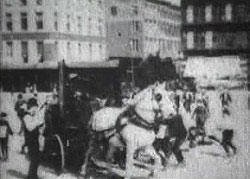 Delivering Newspapers (1903) again from the American Mutoscope & Biography Company, was the co-creation of Billy Bitzer & Arthur Marvin. It begins with a broad street scene of the gathering of "newsies" or newspaper boys in New York City, evidently in Union Square. Delivering Newspapers (1903) again from the American Mutoscope & Biography Company, was the co-creation of Billy Bitzer & Arthur Marvin. It begins with a broad street scene of the gathering of "newsies" or newspaper boys in New York City, evidently in Union Square.
Such lads were frequently homeless, invariably members of gangs who defended their newspaper territories eternally on the verge of vendetta, & always at risk of losing their few pennies daily profit to bigger kids in the streets. From the very beginnings of cinema they were romanticized.
A newspaper van for "The World," drawn by white horse, arrives in the square, with the newsies pursuing it well before it comes to a halt.
A street car passes on its track in the far background. A fist-fight breaks out among a couple of the boys, & so the film closes on a realistically rough & tumble note.
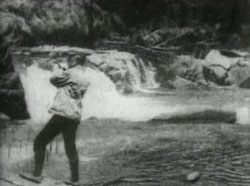 Arthur Marvin left the city for a more pastoral scene in Bass Fishing (1903). It's a bit over a minute, with Henry Talbot hired as the actor for the piece. Arthur Marvin left the city for a more pastoral scene in Bass Fishing (1903). It's a bit over a minute, with Henry Talbot hired as the actor for the piece.
Clad in sporting costume, standing on river's edge with rapids nicely framed in the background just up-river, Henry casts his fly-rod while balancing with somewhat self-concious postures.
He begins to reel in the line, then squats down to reach for his net, & nets a bass on his line.
The fish is clearly already dead so, no, the fishing was not so great that a one-minute film was guaranteed to immortalize a catch.
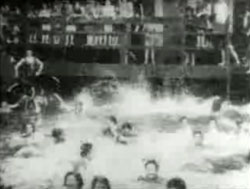 The odd little actuality Women of the Ghetto Bathing (1902), also by Arthur Marvin, is back in the city with quite a dense crowd of women in bathing suits jumping one after another over a railing into a large pool, with many women already bobbing up & down in the frothy water.
The odd little actuality Women of the Ghetto Bathing (1902), also by Arthur Marvin, is back in the city with quite a dense crowd of women in bathing suits jumping one after another over a railing into a large pool, with many women already bobbing up & down in the frothy water.
Why they are designated ghetto women is hard to grasp. Perhaps middleclass or elite women just wouldn't be filmed in swimsuits revealing legs & arms. Perhaps only the poor were objectifiable without repercussion.
It almost seems like it's not an official pool or the gals wouldn't have to climb over a rail to get to the water, although a staircase to get back out of the water is visible on the right. In reality it is a public pool, & Thursdays were "ladies' day" at the New York Public Baths. Bathing suits were rented on the premises, but entry to the pool was free.
Women of the Ghetto Bathing appears to ahve been upon a theme that roused Arthur. He made several other "bathing actualities," i.e., Ladies Day at the Free Baths (1901), Boys Entering Free Bath (1901), Boys Free Public Baths (1901), Saturday at the Free Baths (1901), & the more novel What the Bathing Girls did to the Kodak Fiend (1900).
copyright © by Paghat the Ratgirl
|
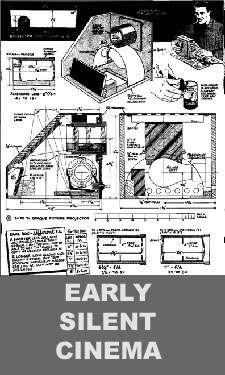

 Robert Kates Bonine did other "labor actuality" films while in Hawaii, such as the half-minute Cutting Cane Sugar (1902).
Robert Kates Bonine did other "labor actuality" films while in Hawaii, such as the half-minute Cutting Cane Sugar (1902). A crew boss stands nearby in his straw hat, hands in pockets, making sure the workers don't slow down.
A crew boss stands nearby in his straw hat, hands in pockets, making sure the workers don't slow down.
 So! We're not in a little "actuality" documentary of the author at home; rather, this is a Trick Film, a jest in keeping with the nature of the author.
So! We're not in a little "actuality" documentary of the author at home; rather, this is a Trick Film, a jest in keeping with the nature of the author.
 Delivering Newspapers (1903) again from the American Mutoscope & Biography Company, was the co-creation of Billy Bitzer & Arthur Marvin. It begins with a broad street scene of the gathering of "newsies" or newspaper boys in New York City, evidently in Union Square.
Delivering Newspapers (1903) again from the American Mutoscope & Biography Company, was the co-creation of Billy Bitzer & Arthur Marvin. It begins with a broad street scene of the gathering of "newsies" or newspaper boys in New York City, evidently in Union Square.
 The odd little actuality Women of the Ghetto Bathing (1902), also by Arthur Marvin, is back in the city with quite a dense crowd of women in bathing suits jumping one after another over a railing into a large pool, with many women already bobbing up & down in the frothy water.
The odd little actuality Women of the Ghetto Bathing (1902), also by Arthur Marvin, is back in the city with quite a dense crowd of women in bathing suits jumping one after another over a railing into a large pool, with many women already bobbing up & down in the frothy water.